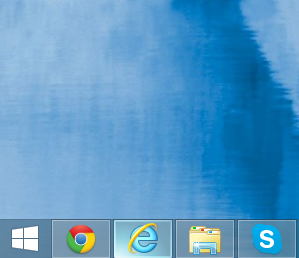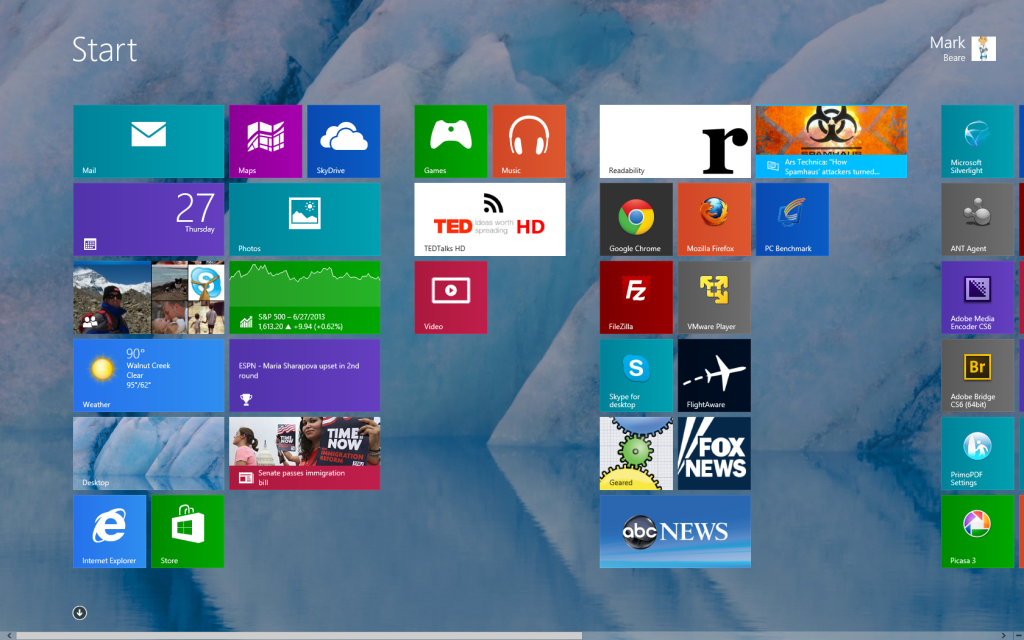-
-
products
-
resources
-
support
-
company
-
The Windows 8.1 Start Menu
By Mark Beare June 28, 2013start button, start menu, start screen, windows 8, windows 8.119 CommentsThe Advent of the Windows 8.1 Start Menu and Start Button
On June 26, Microsoft announced at its Build developers conference the release of the Windows 8. 1 consumer preview. There have been a substantial amount of changes made in 8.1 over Windows 8. Paul Thurrott, the go-to expert on all things Microsoft related, has a comprehensive list of all these changes.
The most anticipated change among experts and users alike has to do with the bottom left hand corner of the Windows desktop — the Start Menu. Enter the Windows 8.1 Start Menu!
It is not a Start Menu, it’s a button
Most people consider the Start Menu and the Start Button to be one and the same. In a recent survey we conducted of random Windows users, 76% of respondents either didn’t know the difference, or thought the Start Menu and Start Button were the same thing. In Windows 8.1, this is not the case. Microsoft introduced the Start Screen in Windows 8 to replace the traditional Start Menu. The new Start button introduced into Windows 8.1 just takes you to the Start Screen. Here is how the new button looks.
As you can see, it just looks like a Windows 8 version of the familiar Start Button, which would have opened the Start Menu in Windows 7 and earlier. This really helps make the Desktop more familiar to users of past version of Windows. When you click the new Start Button, however, you quickly realize you are not in a prior version of Windows.
Microsoft have made changes to the Start Screen to make it less shocking when you are taken here from the Desktop. The way that they have done this is by allowing the option (not a default setting) to use your Desktop background as the background for the Start Screen also. This gives the impression that you are still in the Desktop environment when you enter the Start Screen, even though you are not. I must admit, if you have the Desktop open with no windows open, and you hit the Start Button, then it does feel like you are still on the Desktop. See below for a video of this experience.
The problem is, in reality, people are rarely on the Desktop without having any windows open. Usually there is at least one application open, such as a browser or Outlook or some other application. When you are on the Desktop with at least one window open, the experience of going to the Start Screen is a little more disjointed. See this experience below:
This is still the same disjointed experience people have criticized with the first release of Windows 8. Consider this example: You are working on an Excel spreadsheet or some other piece of work and then you click the Start Button to open another application, and, boom, you can no longer see your Excel spreadsheet or whatever it was you were working on. Where did it go, and how can you get back there?
What you can’t do from the Start Screen
The Start Screen has been introduced to replace the old Start Menu. The old Start Menu did not work very well with touchscreen devices — it was just too hard to try and select anything in the menu with your finger because all the items are too small. The new Start Screen does work extremely well with touch, but there are some things that (especially with a mouse and keyboard) you cannot do at all, or cannot do easily, compared to using a Start Menu. Here is what is missing from the Start Screen compared to the Start Menu:
View Recent Documents
When you have been working on a document over the past couple days, and you wish to quickly open it to continue your work, you used to be able to go to the Recent Items list in the Start Menu. You would find a list of all of your most recent items that you have accessed, which makes finding that recent document quick and easy. In Windows 8 and 8.1, you no longer have a list of recent documents. The only option you have now is to open up the application in which you were using the document, and look at the recently opened documents there, or open the file directly, if you remember where you saved it.
Access the Control Panel
The Control Panel is something that some people do not use often, but when they do, it is usually for important reasons. The Windows Control Panel in Windows 8 is not located on the Start Screen. It is located in the right hand Charms Bar under the Settings option (but only if you are in the desktop when you access the Charms Bar) or you can right click on the new Start Button in Windows 8.1 and access the Control Panel from the menu that comes up there. These are both very different ways to get to the Control Panel compared to earlier versions, and will take some getting used to.
Access the Power Settings
Anyone who has used previous versions of Windows is accustomed to opening the Start Menu and then clicking the Shut Down menu in order to either Sleep, Restart or Power Off their computer. In Windows 8, this has changed. You cannot access power options by clicking the Start Button. To power off your computer, you will need to access the right hand Charms Bar and then click Settings, then Power. Or, right click the new Start Button in Windows 8 and click Shut Down. This is different from what people are used to doing and will take time to get the hang of.
Find what you need quickly
The Windows 8 Start Screen is meant to be easily personalized, and it is, but it requires an investment in your time to do so. Whether you set it up like you want, or leave it in its default state (which I imagine many people will), there is one thing that I find very difficult with the Start Screen — it takes a while to find what I am looking for. This has to do with the tiles on the Start Screen being laid out horizontally rather than vertically. You need to scan each vertical list with your eyes, and then move to the right and scan the next list, and so on until you find what you are looking for, or hit the end without finding it at all. To prove this point, try and find the word Lime in the below list.
Apple
Banana
Blueberry
Grape
Guava
Kiwi
Lemon
Lime
Mango
Melon
Nectarine
Orange
Peach
Pineapple
Strawberry
TomatoI did not even tell you that this list was sorted alphabetically, and I am sure you found the word really quickly. Now try and find the same word Lime in this below table which is sorted like the Windows 8 Start Screen.
Row 1 Row 2 Row 3 Row 4 Orange Apple Pineapple Tomato Strawberry Melon Peach Lemon Mango Nectarine Kiwi Lime Guava Banana Grape Blueberry Have a bit more trouble finding the word this time? This is what it is like every time you want to open an application in Windows 8 from the Start Screen, only the Start Screen has many more objects to scan through and you need to scroll horizontally to view them all.
Access My Documents
My Documents has been a menu item in the Start Menu for a long time, but it not located on the Windows 8 Start Screen. To access My Documents in Windows 8, you need to go through Windows Explorer (which you may need to open from the Start Screen).
If you want a Start Menu back, you can have one
So there are some big changes in the way you access your applications, settings and documents in Windows 8 and 8.1. Some people will like the change and others will really struggle to adapt. The good news is that if you do not like the changes with the Windows 8 Start experience, you can install a more familiar Start Menu, like Start Menu Reviver.

Start Menu Reviver
We developed Start Menu Reviver because we knew that people would have trouble with or simply wouldn’t like using the Windows 8 Start Screen. However, we didn’t think that adding a Windows 7 style Start Menu back into Windows 8 was the best answer to bringing back the Start Menu. Mainly because it can’t be used with touchscreens, and also because we believed that the Start Menu was due for improvement. You can download Start Menu Reviver yourself to try. It is completely free, and if you do not like it you can easily exit it or uninstall it to go back to the Windows 8 default settings. You can download Start Menu Reviver and check out the video for the product below.
What do you think about the changes to Windows 8 and the new Start Screen/Start Button? Please let us know in the comments, and thanks for reading!
Was this post helpful?YesNoFree Driver Updates
Update your drivers in less than 2 minutes to enjoy better PC performance - Free.
Free Driver Updates
Update your drivers in less than 2 minutes to enjoy better
PC performance - Free.
Didn't find your answer?Ask a question to our community of experts from around the world and receive an answer in no time at all.most relevant recent articles Pin It on Pinterest


